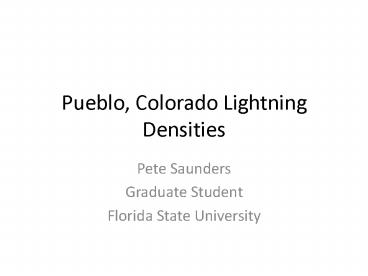Pueblo, Colorado Lightning Densities - PowerPoint PPT Presentation
1 / 20
Title:
Pueblo, Colorado Lightning Densities
Description:
The first graph, entitled Warm Season Hourly Counts' gives a seasonal ... The warm season indicates the months of April through September over an 11 year period. ... – PowerPoint PPT presentation
Number of Views:37
Avg rating:3.0/5.0
Title: Pueblo, Colorado Lightning Densities
1
Pueblo, Colorado Lightning Densities
- Pete Saunders
- Graduate Student
- Florida State University
2
Time Series
- The following graphs depict the total
flash counts versus the time they occur. The
times have been converted from UTC to Mountain
Standard Time (MST). The first graph, entitled
Warm Season Hourly Counts gives a seasonal
representation of the time in which most
lightning flashes occur in Colorado. The
subsequent graphs are a month by month
illustration. - The warm season indicates the months of
April through September over an 11 year period.
Finally, the area represented in the plots is
between - Latitude 35.0 N through 42.0 N
- Longitude -102.0 W through -110.0 W
- Please note The ordinate axes of the
following graphs are not to scale
3
(No Transcript)
4
(No Transcript)
5
(No Transcript)
6
(No Transcript)
7
(No Transcript)
8
(No Transcript)
9
(No Transcript)
10
(No Transcript)
11
Remarks
- Examining lightning counts temporally
illustrates the convective nature of the
atmosphere climatologically throughout the warm
season. - There is a subtle shift in peak lightning
counts toward later in the afternoon from April
through July. - July and August have the highest CG flash
counts with July being a bit more active, just
over 450 000 flashes, compared with slightly less
in August. - There is a rapid decrease in activity from
August to September with average flash counts of
approximately 160 000.
12
Spatial Density Maps
- The following maps depict the spatial
densities of CG lightning flashes for the Pueblo,
Colorado region. The first map, entitled Warm
Season Flash Density, is a seasonal
representation for the entire warm season. The
subsequent maps present a month by month
comparison of CG flash density. - Please note
- The coordinates for the density maps are the
same as previously mentioned for the time series.
- The color bar represents different flash
densities for each month in order to isolate
features of interest.
13
Highest densities occur just to the north of
Pikes Peak within the Palmer Divide
Relatively high densities in the southern portion
of the Sangre de Cristo Mountains
Noticeably lower values of lightning densities
within San Luis Valley region
14
Interesting area of relatively high densities
here in the northeastern plains.
15
(No Transcript)
16
Higher lightning densities probably associated
with the Denver Convergence Vorticity Zone.
17
(No Transcript)
18
(No Transcript)
19
(No Transcript)
20
Remarks
- These lightning densities look quite similar to
those depicted in Lightning Climatology for the
State of Colorado (Hodanish 2006). - The highest densities are over the Palmer Dive
region just to the north of Pikes Peak. The
Denver Convergence Vorticity Zone may as well
contribute to this hot spot. Also, the southern
portion of the Sangre de Cristo Mountain Range
has relatively high densities, as does the Raton
Mesa region. - Low lightning densities occur as expected in the
San Luis Valley, and in eastern Colorado in the
Plains region. - The western portion of the state (Sawatch Range
and westward) has too many high mountains
blocking the moisture, thus inhibiting
convection. - Steve Your paper has been extremely helpful in
understanding patterns of lightning during the
warm season in Colorado. - Any further input or suggestions on the overall
convective nature of the warm season or why the
highest/lowest lightning densities appear where
they are would be greatly appreciated. Also,
please share this document with your forecasters
in order to facilitate feedback and understanding.































